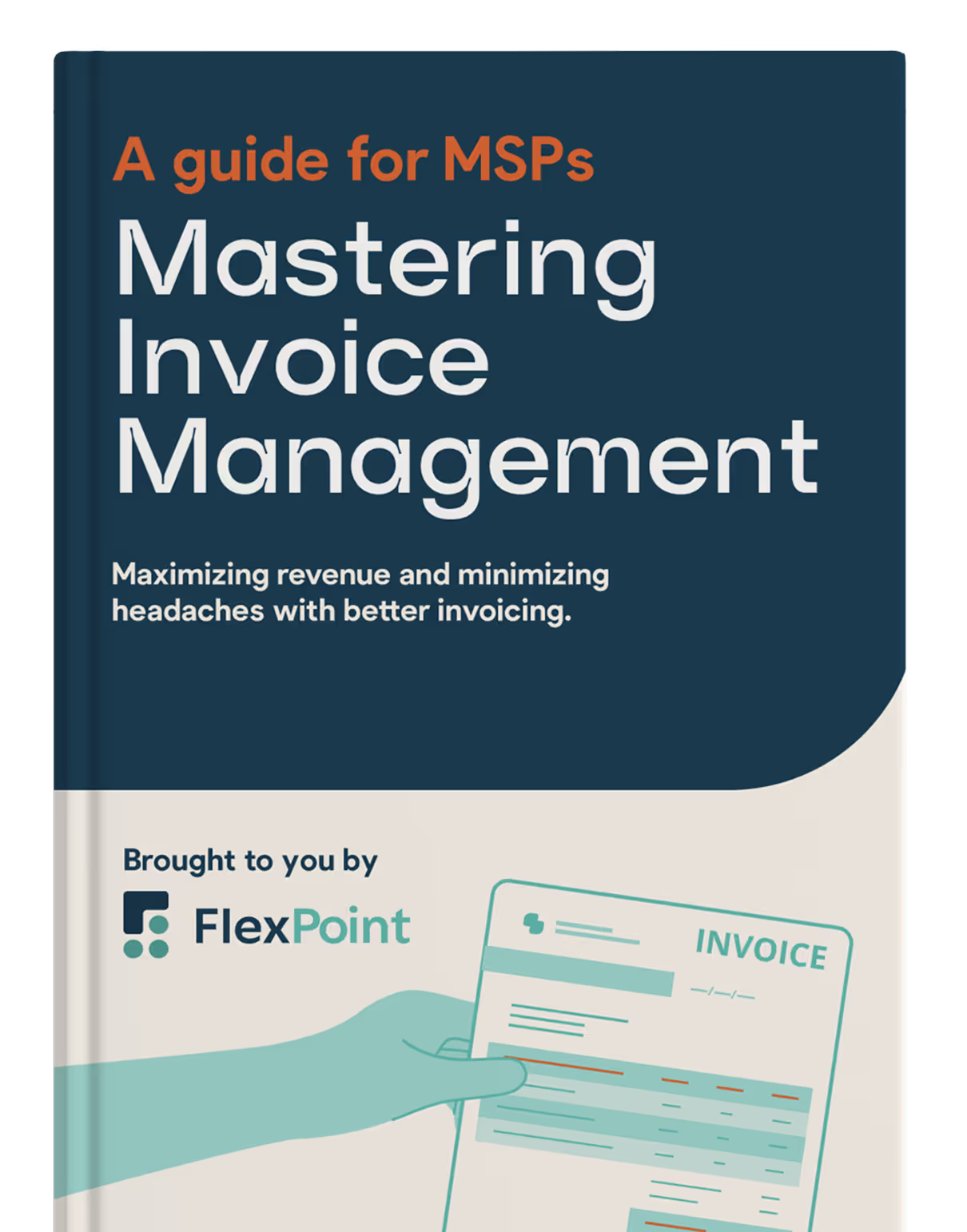MSP Per User Pricing: A Scalable Model for Growing Managed Service Providers
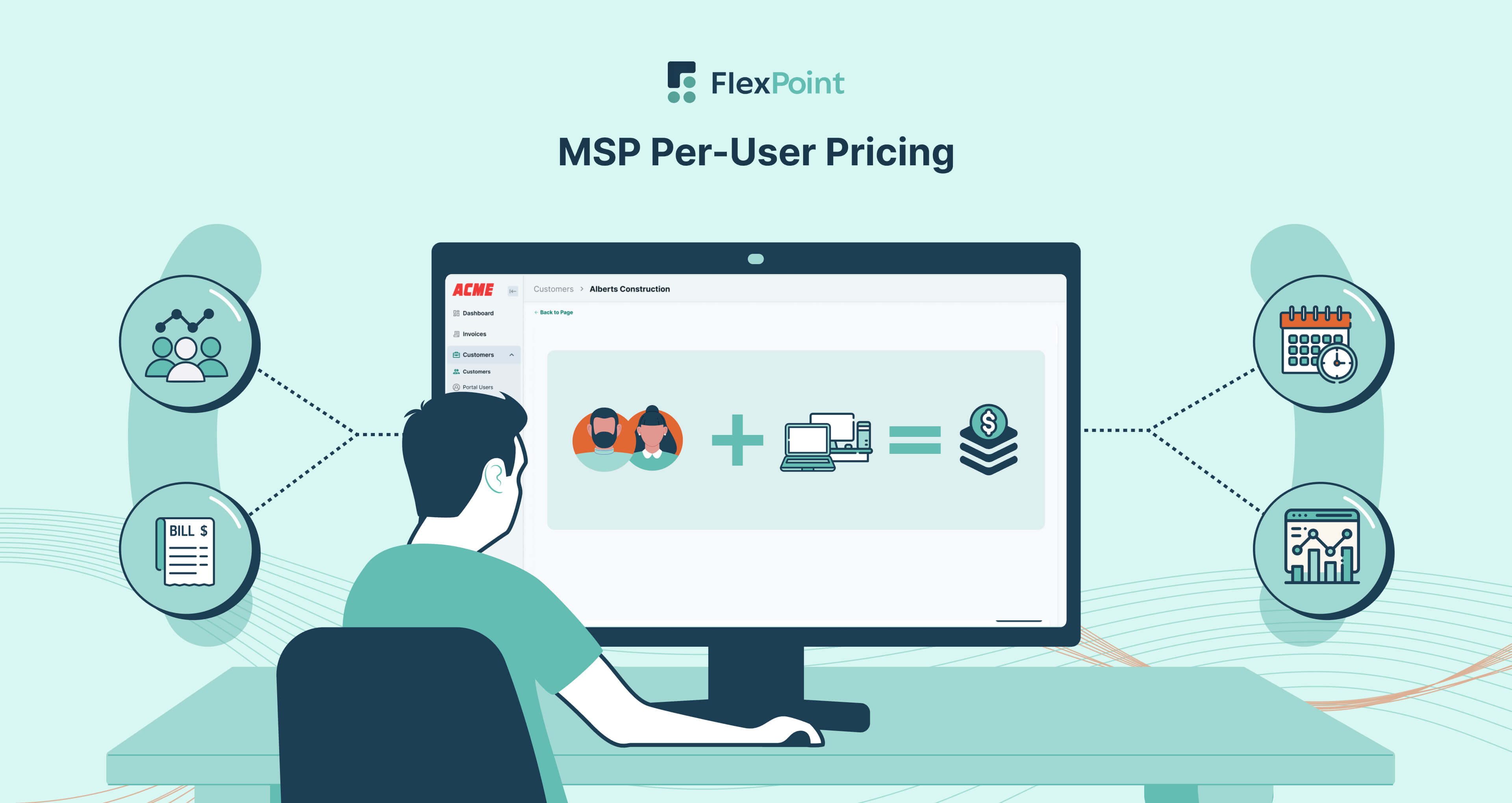
Per-user pricing has become a popular model among managed service providers (MSPs) seeking a scalable and consistent way to charge clients. This model charges a flat monthly fee per user, rather than per device or per hour, making it simpler for clients to understand and easier for MSPs to manage their costs.
One key reason this model has gained traction is the rise of hybrid and remote work. According to a recent Gallup poll, 52% of remote-capable employees work in a hybrid model, while only 21% work entirely on-site. With employees accessing systems from multiple devices across various locations, billing based on hardware is more challenging to track and justify.
Per-user pricing reflects this shift. It enables MSPs to provide comprehensive, user-focused support without manually adjusting billing every time a device is added or removed.
Instead of tracking equipment such as laptops, smartphones, and tablets, MSPs track which user is being supported. This makes it easier to align billing with the actual structure and behavior of today’s workforce.
Clients appreciate this clarity. They can forecast IT costs based on headcount, which is typically more stable than device inventory. MSPs, in turn, benefit from recurring revenue tied directly to the number of individual users they support. This alignment simplifies agreements, improves communication, and supports growth.
In this article, we’ll explain what per-user pricing is, outline its pros and cons, and describe when it’s most effective.
We will also share strategies for implementing it efficiently and show how MSP-specific payment automation software can support MSPs that use this approach.
{{toc}}
What Is MSP Per-User Pricing?
Per-user pricing means billing clients a flat fee for each supported user, usually defined as an employee or identifiable system login. This covers all the devices that a particular person uses, including laptops, phones, and tablets.
Unlike per-device models, which charge separately for each piece of hardware, per-user pricing aligns with how businesses operate today: people rely on multiple devices to work from various locations.
It also simplifies invoicing and client communication. Clients know what to expect and how fees will scale if they add or remove employees. For MSPs, per-user pricing reduces billing errors and administrative overhead.
Instead of tracking device counts, MSPs can sync billing with ticketing systems or PSA tools that monitor user accounts to streamline the process. It's a clean model for modern IT environments where device numbers are unpredictable, but user counts remain steady.
{{ebook-cta}}
Pros and Cons of Per-User Pricing for MSPs
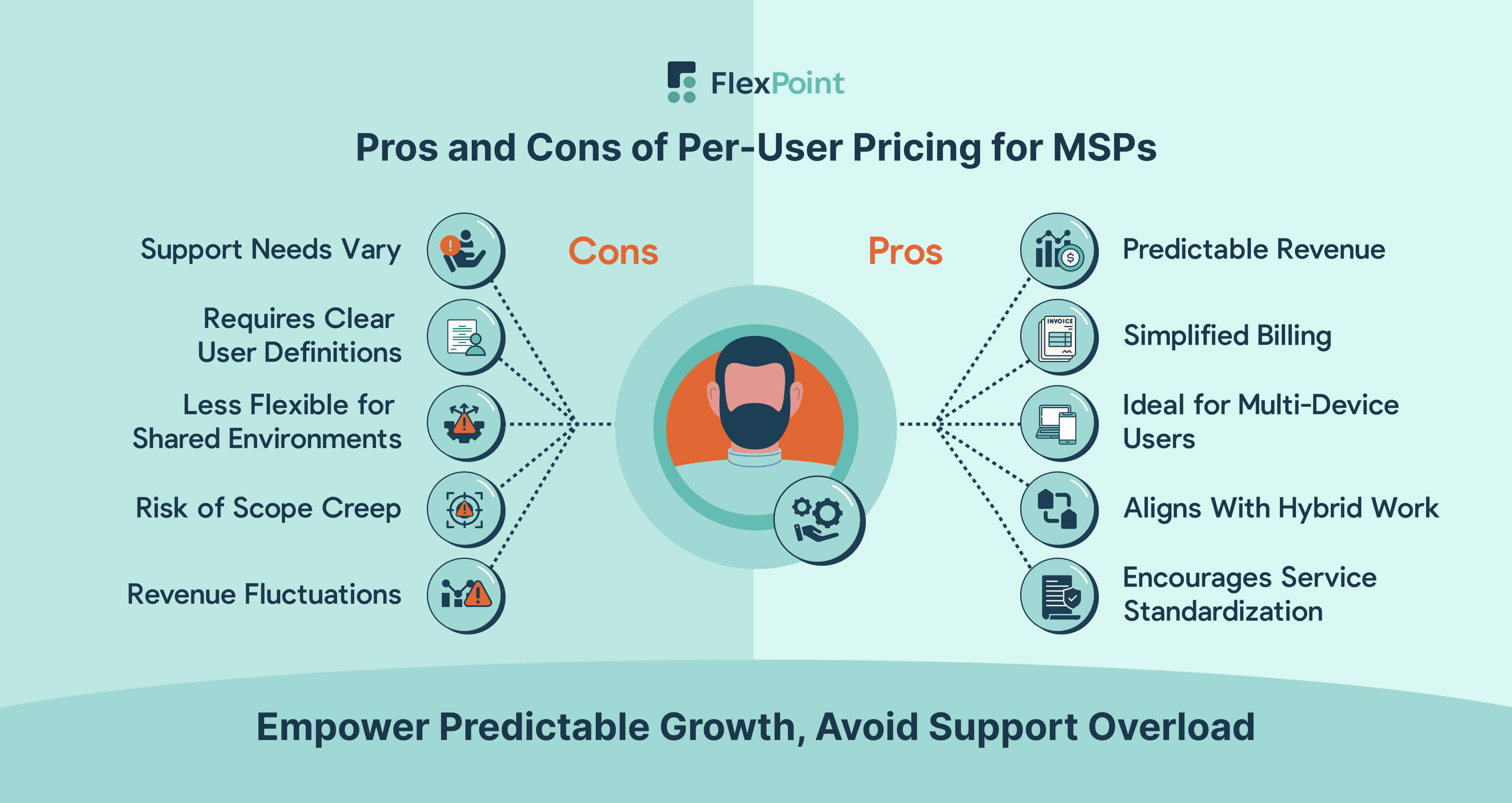
Before adopting per-user pricing, it’s important to weigh the advantages and limitations of this model. While many MSPs find that it supports consistent revenue and easier billing, it’s not ideal in every situation.
The benefits are strongest in environments with predictable user needs and device usage.
Below is a breakdown of the main pros and cons to help MSPs decide whether this model suits their service delivery and client base:
The Pros of Per-User Pricing:
- Predictable Revenue: Per-user pricing provides MSPs with a recurring revenue stream directly tied to client headcount. This predictability helps with budgeting, hiring, and service planning.
- Simplified Billing: It’s easier to explain a per-user fee than a complex per-device breakdown. Clients appreciate the transparency and consistency.
- Ideal for Multi-Device Users: Most employees use more than one device. Per-user pricing accommodates this by charging a single rate for all equipment.
- Aligns With Hybrid Work: In remote or hybrid setups, users may access company systems from multiple devices and locations. A user-focused pricing model ensures comprehensive support for each individual, regardless of their work location or method.
- Encourages Service Standardization: By charging the same fee per user, MSPs are incentivized to create repeatable, efficient service processes that deliver consistent value.
The Cons of Per-User Pricing:
- Support Needs Vary: Not all users consume support equally. Some individuals may require constant assistance, while others rarely need help. Flat rates can lead to perceived value imbalances.
- Needs Clear Definitions: What qualifies as a "user" must be clearly defined. Shared logins, contractors, or seasonal staff can complicate billing.
- Less Flexible for Shared Environments: Industries with many shared devices or rotating staff (like retail or manufacturing) may not suit this model.
- Risk of Scope Creep: Without defined service limits, clients may expect unlimited support for each user, thereby increasing the workload without generating additional revenue.
- Revenue Fluctuations: If a client downsizes, your revenue drops. MSPs need to ensure minimum fees are in place or maintain a broad client base to stabilize income.
When Per-User Pricing Works – And When It Doesn’t
Per-user pricing is most effective in modern, knowledge-based industries where employees utilize multiple devices. Law firms, marketing agencies, and tech companies are a few prime examples. These clients value simplicity and expect comprehensive support across devices.
It also fits MSPs offering standardized, all-inclusive services. When each user receives the same level of support, pricing them uniformly makes sense.
However, it may not work well for clients in environments with many shared devices or part-time users. Factories, warehouses, or retail operations often have multiple users sharing the same workstation. In those cases, per-device or hybrid pricing may better reflect the actual workload.
It can also be a poor fit for clients with highly variable user needs. For example, an engineering firm may have technical staff needing intensive support and admin staff with minimal IT needs. A single per-user rate may overcharge some and undercharge others.
In short, per-user pricing is most effective when user roles are uniform and each employee relies heavily on IT. It becomes less suitable in environments with shared equipment or uneven support demands.
How to Implement and Optimize Per-User Pricing in Your MSP: 5 Proven Strategies
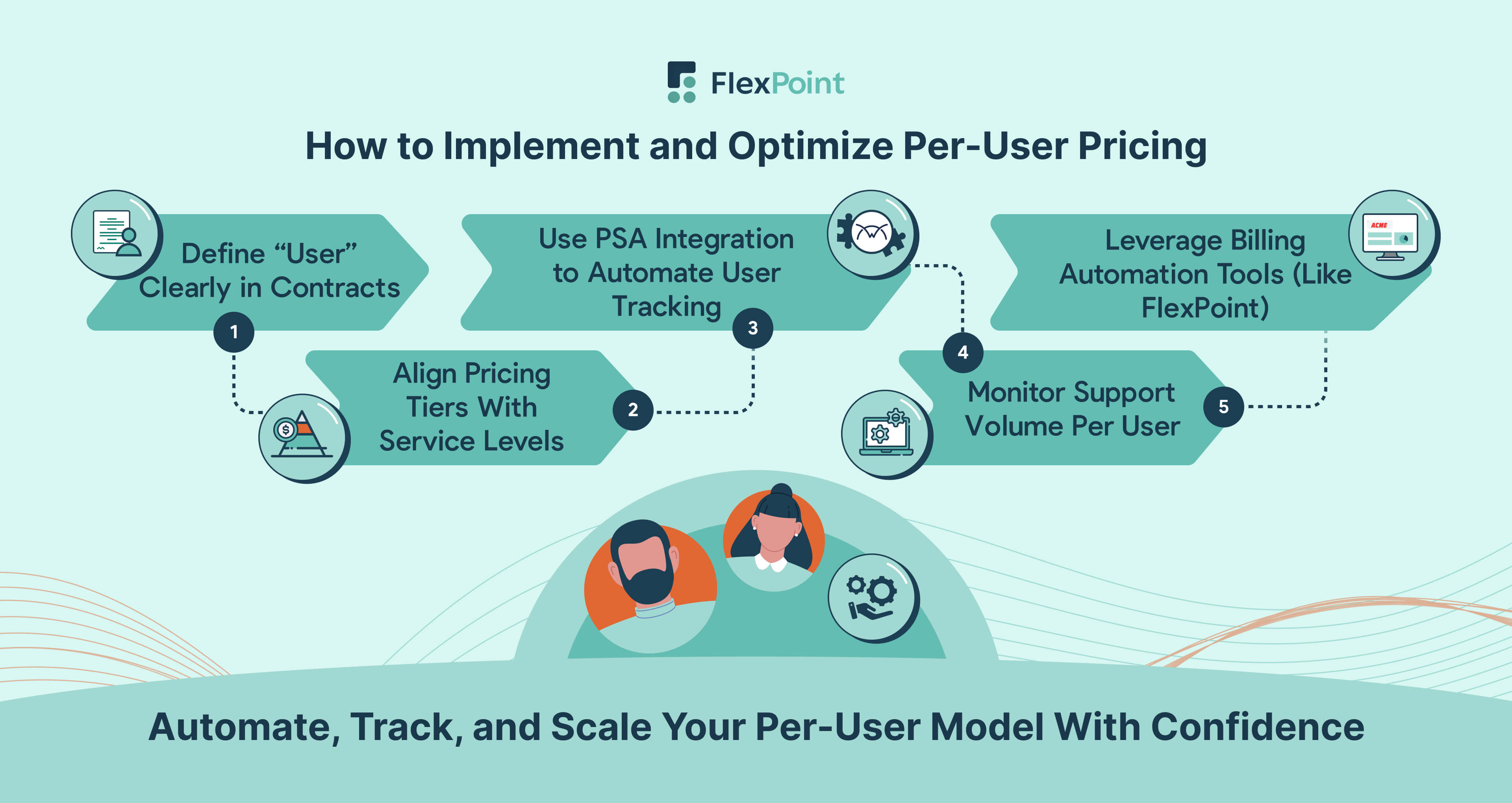
Adopting per-user pricing requires some planning and the right tools to ensure it runs smoothly.
Here are key strategies for implementing and managing a per-user model effectively in your MSP:
1. Define “User” Clearly in Contracts
Begin by defining precisely what constitutes a “” for billing purposes. Generally, it means a unique employee or end-user account that your team supports. Spell this out in your Master Service Agreement and client contracts.
For example, specify that each active employee with an email account or endpoint device under management is considered a billable user.
By standardizing this definition, you avoid confusion when invoicing. If a client asks whether a shared team login or a temporary intern is billed as a separate user, you’ll have a clear, pre-defined answer. This clarity sets the foundation for fair and consistent billing.
2. Align Pricing Tiers with Service Levels
If you offer multiple service packages or tiers, integrate the per-user model into those tiers. For instance, you might have a “Standard” support plan at $X per user and a “Premium” support plan (with additional services such as virtual CIO and cybersecurity) at $Y per user.
Ensure that the per-user rate reflects the service level provided – higher-touch service or broader coverage should carry a higher per-user fee. This alignment helps you maintain margins and lets clients choose a package based on value, not just device count.
It’s also wise to set a minimum user count or monthly fee for very small clients so that your costs are covered even if a client has just a few employees.
3. Use PSA Integration to Automate User Tracking
Manually tracking the number of users each client has can become tedious, especially as clients hire or terminate employees. Leverage your PSA tools by integrating them with your billing system.
For example, connect your PSA (like ConnectWise or Autotask or SuperOps or HaloPSA) to your invoicing platform so that any addition or removal of a user in the PSA automatically updates your billing. A connected system ensures that you never miss billing for a new hire or accidentally bill someone who has left. It also provides a single source of truth for user counts.
4. Monitor Support Volume Per User
Once you’re billing per user, keep an eye on how much support each user (or each client’s average user) is consuming. Use your ticketing system or PSA reports to identify whether certain users or certain clients consistently require far more support than others.
These insights can inform you if your per-user fee is set correctly. For instance, if you find that one client’s users log double the number of tickets than another’s, you might need to adjust pricing for that client or set expectations about what’s covered.
Regularly review metrics like tickets per user or hours per user across your client base. This will help you optimize your service delivery and pricing. You could introduce tiered per-user pricing based on usage or provide extra training to high-need clients to reduce their ticket volume.
5. Leverage Billing Automation Tools
The right software can make per-user pricing practically effortless to manage. FlexPoint is an MSP-focused billing platform that automates per-user invoicing and payments.
FlexPoint supports tiered pricing structures and customizable line items, allowing you to easily implement per-user charges alongside other fees. Crucially, it also provides reporting to track revenue per user or per client, giving you real-time insight into how your user-based billing is performing.
Conclusion: Scaling Profitability and Simplicity with Per-User Pricing
For many MSPs, per-user pricing is a reliable, scalable billing model. It establishes a direct connection between client growth and MSP revenue, while providing clients with clarity and consistency. As workforces become more distributed and device usage multiplies, user-based billing reflects how IT services are actually consumed.
The model works especially well when paired with standardized service offerings and good automation. MSPs can streamline operations, enhance client satisfaction, and eliminate billing confusion. Flat rates tied to users eliminate the guesswork of device inventory and help build stronger, longer-term client relationships.
Of course, per-user pricing isn’t perfect. It requires clear definitions, consistent service levels, and ongoing monitoring to ensure effective operation. Hybrid models will better serve some environments. However, when applied thoughtfully, per-user pricing supports stable growth and predictable cash flow.
Deploy per-user billing with confidence using FlexPoint.
Automate billing, simplify contracts, and scale your MSP with a model that grows with your clients.
Schedule a demo to see how FlexPoint supports flexible, user-based billing strategies.
{{demo-cta}}
Additional FAQs: MSP Per-User Pricing
{{faq-section}}



